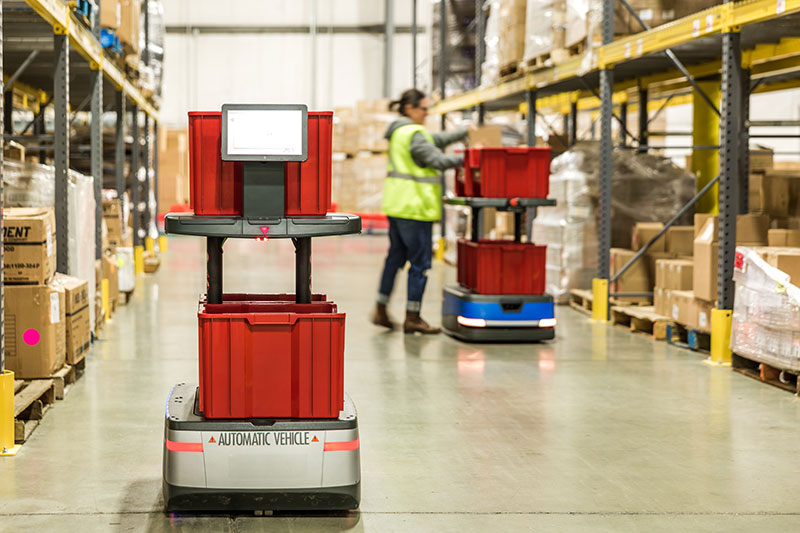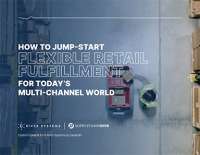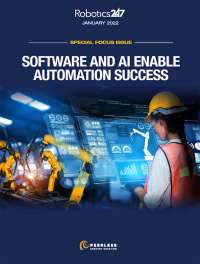I live in a state whose motto is “Live Free or Die.” If the third-party logistics (3PL) industry had a motto these days, it might be “Innovate or Die.”
“At NFI, we have followed the guidance ‘if you’re not growing, you’re dying,’” says Sid Brown, CEO. “Throughout each generation since our founding in 1932, we have been strategic and creative in how we grew. Today, innovation is essential in how we grow and enhance the value we bring to customers.”
NFI at a glance
Founded: 1932 by Israel Brown
Ownership: Privately held by the Brown family
Headquarters: Camden, New Jersey
Annual Sales: $2 billion+
Facilities: 350 locations across North America, comprising 50 million square feet
Assets: 3,000 trucks and 12,500 trailers, including more than 750 temperature-controlled trailers
Employees: 13,100+
That is especially true of the e-fulfillment side of the industry, where shippers are counting on 3PLs to compete with the behemoths of the e-commerce world. In fact, those shippers are increasingly asking their 3PL partners to detail their technology roadmaps before signing on.
“Questions about innovation are in every bid we do now,” notes Darin Richards, regional vice president of operations for privately held NFI, a New Jersey-based 3PL operating 50 million square feet of warehouse space in 350 locations around the country, along with a dedicated fleet of more than 3,000 trucks and 12,500 trailers. “For the last two to three years, it’s come up in every quarterly business review with a customer. Everyone is pushing the envelope and asking what we can do for them from an innovation standpoint.”
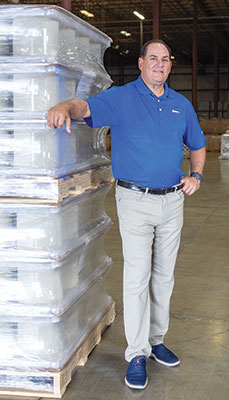 NFI’s answer for one of its clients was a fleet of eight autonomous mobile robots (6 River Systems), or AMRs. The AMRs have been operating for about 18 months in a 380,000-square-foot, multi-tenant facility in Lebanon, Ind. There, the robots replaced a legacy RF-directed, pick-to-cart operation at a region where the labor market was tight, training was a challenge due to turnover and NFI, like everyone in the e-commerce fulfillment market, was looking for ways to address peak seasonality beyond throwing more labor at the problem. AMRs addressed all three issues.
NFI’s answer for one of its clients was a fleet of eight autonomous mobile robots (6 River Systems), or AMRs. The AMRs have been operating for about 18 months in a 380,000-square-foot, multi-tenant facility in Lebanon, Ind. There, the robots replaced a legacy RF-directed, pick-to-cart operation at a region where the labor market was tight, training was a challenge due to turnover and NFI, like everyone in the e-commerce fulfillment market, was looking for ways to address peak seasonality beyond throwing more labor at the problem. AMRs addressed all three issues.
“We were seeing increasing wage pressures, and during seasonal surges we had a hard time getting employees,” says Richards. “AMRs didn’t just allow us to increase our productivity; they also allow us to handle volume surges without adding labor. And, there’s a very quick turnaround time on training.”
He adds, “We aren’t replacing full-time employees with automation. We have always had flex labor for seasonal surges, and there have been times in recent years when additional labor was not available, period. The robots help our full-time associates be more productive so we don’t need to add as much temporary help. And, they like working with them: At home, they’re telling their families how they’re working with robots.”
The results: Pick rates improved from 35 picks per hour to as many as 100 picks per hour on some customer profiles, according to Ralph Dieringer, who was director of operations at the Lebanon facility during implementation in September 2018. Dieringer adds that “80 to 85 picks per hour utilizing AMRs and including dwell time, is more common. AMRs have brought a conveyable solution to an area where we never thought we could automate. We always used a cart or a reach truck.”
Innovating with robots
NFI, a leading international third-party logistics provider with customers that span multiple industries across the Fortune 500, was founded by Israel Brown in 1932 as National Hauling in Vineland, N.J. The first warehouse and truck terminals went up seven years later, in 1939. The company, which remains privately held by the Brown family, has grown steadily since to more than $2 billion in annual sales and more than 13,100 employees.
“Innovation has played a paramount role in NFI’s evolution and how we have been able to navigate the rapid pace that the supply chain industry has changed,” says Brown. “By investing in the right people and the right technology, we are able to engineer unique solutions that provide customers with the agility and flexibility that today’s logistics landscape requires.”
For nearly 90 years, NFI has grown organically and through strategic acquisitions. Over the past several years, NFI has invested in innovation, including strategic hires and the development of an Innovation Delivery Method for identifying, validating and deploying technologies that can improve customer outcomes at scale (see box, p. 24). Today, NFI’s innovation portfolio includes electric and natural gas vehicles, solar energy, artificial intelligence, automation and robotics. The 3PL also participates in the Blockchain in Transport Alliance initiative.
The adoption of AMRs is a good illustration of the Innovation Delivery Method in action, according to Jimmy Shafer, senior vice president of integrated design and solutions, who shepherded the project. The initiative began in 2017 as part of the company’s review of its customers’ needs, including the primary tenant in the Lebanon facility.
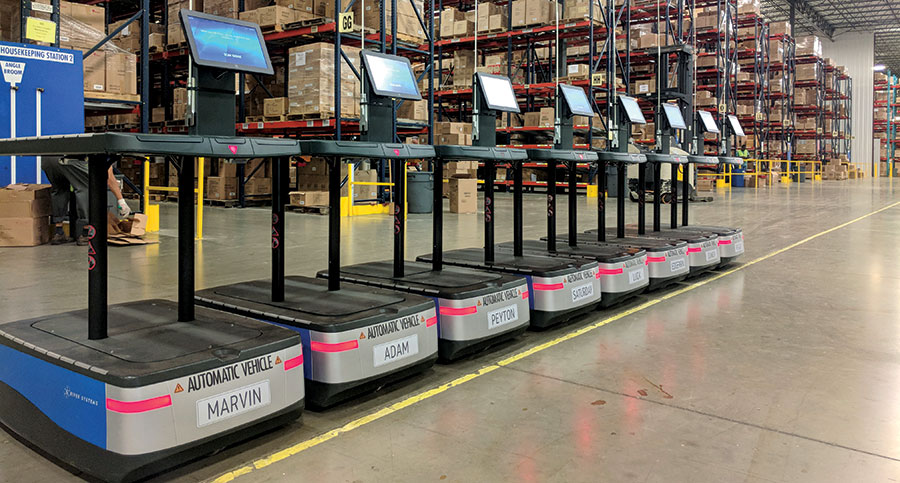
This particular customer experienced a significant spike in order volume during the peak holiday season. Keeping up with that demand in a tight labor market was a challenge. “We knew we needed technology that would allow us to bring on capacity with seasonal surges, and we wanted to support the human operator base with automation that can easily integrate,” Shafer recalls.
In addition, NFI was looking for technologies that could improve safety and could be shared between sites for better utilization. As an example, NFI operates multiple buildings near the Indiana site, which might have surges at different times than the Lebanon facility. A fleet of AMRs could be easily transported and implemented in one of those other locations.
Innovation Challenges are a facet of NFI’s process. During one of these events, cross-functional teams are assigned an operating leader and the requirements of specific customers. The teams then go into the field, including industry events, to hunt for practical technologies to address those problems.
In this instance, a team went to ProMat, where they met with AMR solution providers, including 6 River Systems. The list was shortly narrowed to one. As Shafer notes, “we had a good engagement with 6 River and went to see sites where they were live. We wanted to interact and work with their AMRs at another site so we could experience how the interface works. Once we did that, we realized there was a fit.”
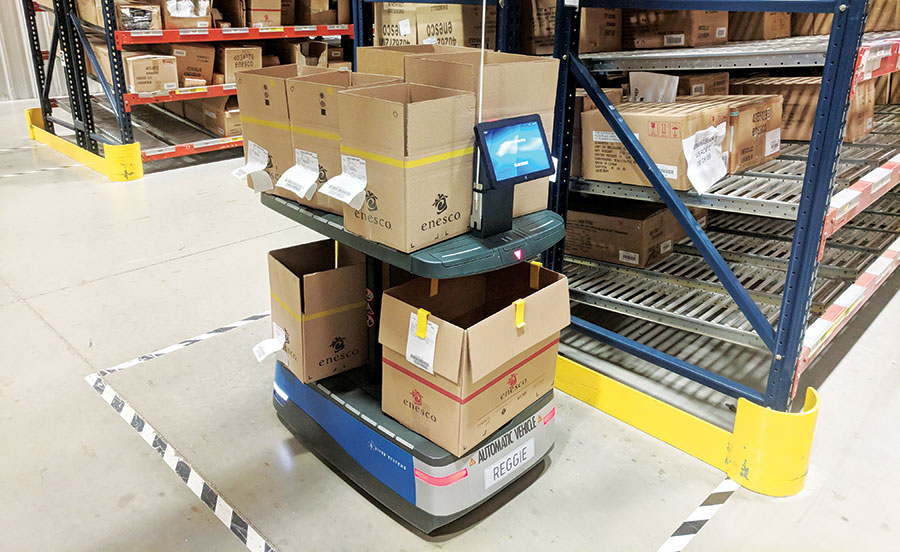
The next step was to generate a business case, and then validate it on site with a pilot using one AMR. Shafer says it was important to identify any barriers to delivering the expected result and to understand the integration requirements between the robotic software and the warehouse management system (WMS). “That was actually pretty simple and helped the process move fast,” Shafer says.
With the business case validated, Shafer believed they were onto something that was ready to bring to the review board at a quarterly business review. As Richards recalls, “When the review board saw it, they were excited. It was going to allow us to handle volume surges without adding labor, there was a quick training turnaround time, and there was a safety aspect to it because associates aren’t pushing carts. It was the right thing to do for our customer, because we could pass the cost savings on to them.”
With approval of senior management, implementation began at the Lebanon facility. “We spent a lot of time talking to the local team, so they understood what the AMRs would do,” Shafer says. “Processes were rewritten, and we changed how we did things on the floor.” For a time, they ran robots in parallel with the conventional pick-to-cart process.
The Innovation Delivery Method
According to Kevin Patterson, president of distribution operations, NFI launched a formal focus on innovation about three years ago. “We knew we needed to look at things differently,” he says. “Part of it was the availability of labor and part of it was the changing requirements of our customers.”
A third leg of that stool was that the economics of technology, particularly in, but not limited to, materials handling. A third-party logistics (3PL) provider, Patterson notes, is hard-pressed to invest in an automated storage and retrieval system (AS/RS) or automatic guided vehicles because customers and their needs change frequently in that industry.
They’re expensive and difficult to redeploy for another customer. Over the last five years, however, the introduction of technologies like autonomous mobile robots (AMRs) and goods-to-person systems like those from AutoStore, which NFI has also implemented, has put automation in reach.
“The price has come down, the technologies are more reliable and more flexible,” Patterson says. “If the needs in one of our facilities change, I can redeploy an asset like an AMR and not get hurt by it.”
Perhaps last, the market is demanding it. “Unless you’re constantly implementing new solutions, you risk becoming obsolete very quickly,” he notes. “We had to think about how to make our DCs showcases for our customers.” Today, he adds, “Innovation is critical to NFI. We’ve created a board to review what we’re doing on a quarterly basis and ownership is part of that. We share what’s going on and decide what we’re going to invest in.” In fact, the company has some staff development goals that tie into innovation.
About three years ago, NFI brought on Jimmy Shafer as the senior vice president of integrated design and solutions to oversee the design of customer solutions and the engineering work for delivery and support of ongoing operations. Shafer oversaw the project that led to the implementation of autonomous mobile robots in the Indiana facility.
The innovation team, which reports to Shafer, uses a multi-step Innovation Delivery Method to applied innovation at NFI. It begins with investigating the market for technologies that might further NFI’s customers, identifying strategic partners who can address practical problems, pilot and prove the concept, and finally, implement and scale it.
“We’re focusing on technologies that help us digitize our manual processes and drive labor savings as a 3PL,” notes Barbara Gress, NFI’s director of engineering and innovation. “Those are in four buckets, and include automation, wearables, data analytics and the Internet of Things.”
In addition to autonomous mobile robots, for instance, NFI is looking at ways to use technologies to build upon one another, like adding a robotic picking arm to an AutoStore solution or integrating automatic guided vehicles with a conveyor shuttle system.
Outside the four walls of the warehouse, NFI is piloting a solution to develop a fully automated yard with autonomous vehicles to move trailers. “We’re taking the demand that we see in our customer portfolios, and then boiling that down to the different technologies we want to focus on,” Gress says.
Learning curve
There was a learning curve for both NFI and 6 River Systems, recalls Dieringer. He joined NFI from FedEx about the time the software integration was finishing up and operationalization of the robots was about to begin.
As an example, the scanner that came with the robots wasn’t designed to scan very small bar codes, which led to an adjustment. Dieringer worked with the robot solution provider on how to release orders to the floor that optimized travel and utilization of the robots. “I wanted to be sure we were releasing the work in a way that the robots were moving 100% of the time when they were working,” he recalls. The goal was to create a workflow that allowed one order selector to keep two robots busy all the time.
According to Dieringer, the AMR fleet went live in September 2018, and by November, the system was fully operational and delivering results. At that time, he began working with the solution provider to develop new reports, such as a dwell report that identified how long a robot was idle, followed by heat maps that identified the location of picks—that provided feedback on how well they were slotting. By December 2018, NFI felt confident enough to bring in the customer to show off the solution, which was well received.
With nearly two years of experience, Shafer notes that AMRs are providing the flexibility to do more cluster or batch picking. What’s more, NFI is looking now to expand the duties of the AMRs to include less-than-truckload orders that currently still picked to a cart.
Finally, AMRs are leading to a safer and more productive environment. “We have improved productivity by as much as 170% with low capital intensity,” Shafer says. “We have also improved our quality and accuracy, which don’t always end up in the business case. And last, there was enhanced employee morale, the environment is even safer and our associates have increased job satisfaction.”
Working with Autonomous Mobile Robots
Company: NFI
Location: Lebanon, Ind.
Size: 380,000 total square feet
Throughput: 6,000 items picked per day, with capabilities of up to 15,000 a day during peak
Products Handled: Figurines and super-hero-related products
SKUs: 4,700
Shifts per day/ Days per week: 2 shifts, 5 days a week; operating 7 a.m. until midnight
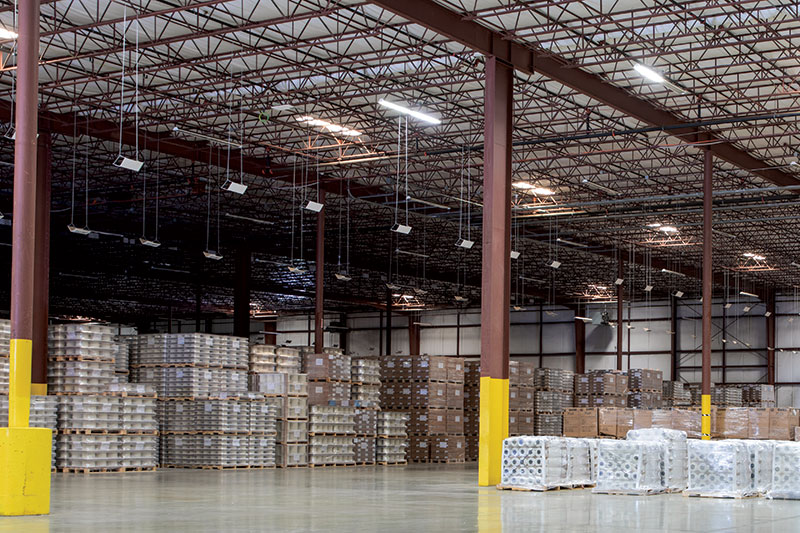
Autonomous mobile robots have transformed e-commerce order fulfillment at NFI Industries’ Lebanon, Ind., facility.
Autonomous mobile robots, or AMRs, are driving efficiencies in the e-fulfillment operations and creating a safer, more worker-friendly environment. For now, the robots are dedicated to one customer.
Receiving: All incoming inventory is received in floor-loaded shipping containers. The containers are manually unloaded to pallets and scanned into NFI’s warehouse management system (WMS). Putaway by reach trucks is system directed.
Pick module storage: Replenishment of the picking area is also system directed: The WMS sends a task to an associate, who retrieves the required pallets and cartons from storage and then scans them into a picking location. The picking area includes full pallet pick locations as well as flow rack for fast movers. The determining factors are the velocity and the size of the items. Pallet locations are located at the front and rear of the pick faces. The products stocked are often determined by the season.
Order fulfillment and packing: The WMS creates a wave of orders based on fulfillment criteria, such as order cutoff times, and then releases it to the floor. The workload is divided between the AMRs and a legacy system still in operation for RF-based picking to carts.
Pick-to-cart: For the most part, the pick-to-cart process is reserved for less-than-truckload (LTL) customers. Orders for that area are sent to operators, who push the cart through the pick module and scan their picks to carton locations on the cart. When a wave of picks is complete for that cart, it’s delivered to an induction station for LTL packing. The cartons are verified; additional packaging, like bubble wrap, is added if needed; a packing slip is printed and the shipping label is affixed. At that point, the carton is sealed, palletized and awaits shipment.
E-commerce fulfillment: Waves are also created for e-commerce fulfillment, but are dropped to the robotic software, which determines the most efficient travel path based on business rules and order priorities. Order selectors are able to stay in the zone assigned to them, reducing their travel during a shift.
Each AMR can carry six to eight cartons on the top shelf, depending on the size of the carton; there is also room for more cartons on the bottom shelf if necessary. The AMR travels from one pick location to the next assigned to it, where an associate scans the picked item or items into a designated carton. When all of the items for that AMR have been picked, the AMR is directed to a parcel packing station. There, cartons are unloaded onto a roller conveyor. Once all of the cartons have been unloaded at packing, the AMR returns to an induction point, where it is reloaded with cartons and begins picking again. Robots, and manual carts, can also be directed to a “jackpot” line, which is used for orders that require an item that wasn’t in the pick module during picking.
At the parcel packing station, an associate scans the carton ID label and does a quality check of the contents. Packing materials, like bubble wrap, are added if required. After that, a packing slip is added, the shipping label is applied, and the box is sealed and conveyed to an accordion conveyor for loading onto a parcel carrier.
About the Author
Follow Robotics 24/7 on Linkedin
About the Author
Follow Robotics 24/7 on Linkedin
Article topics
Email Sign Up

